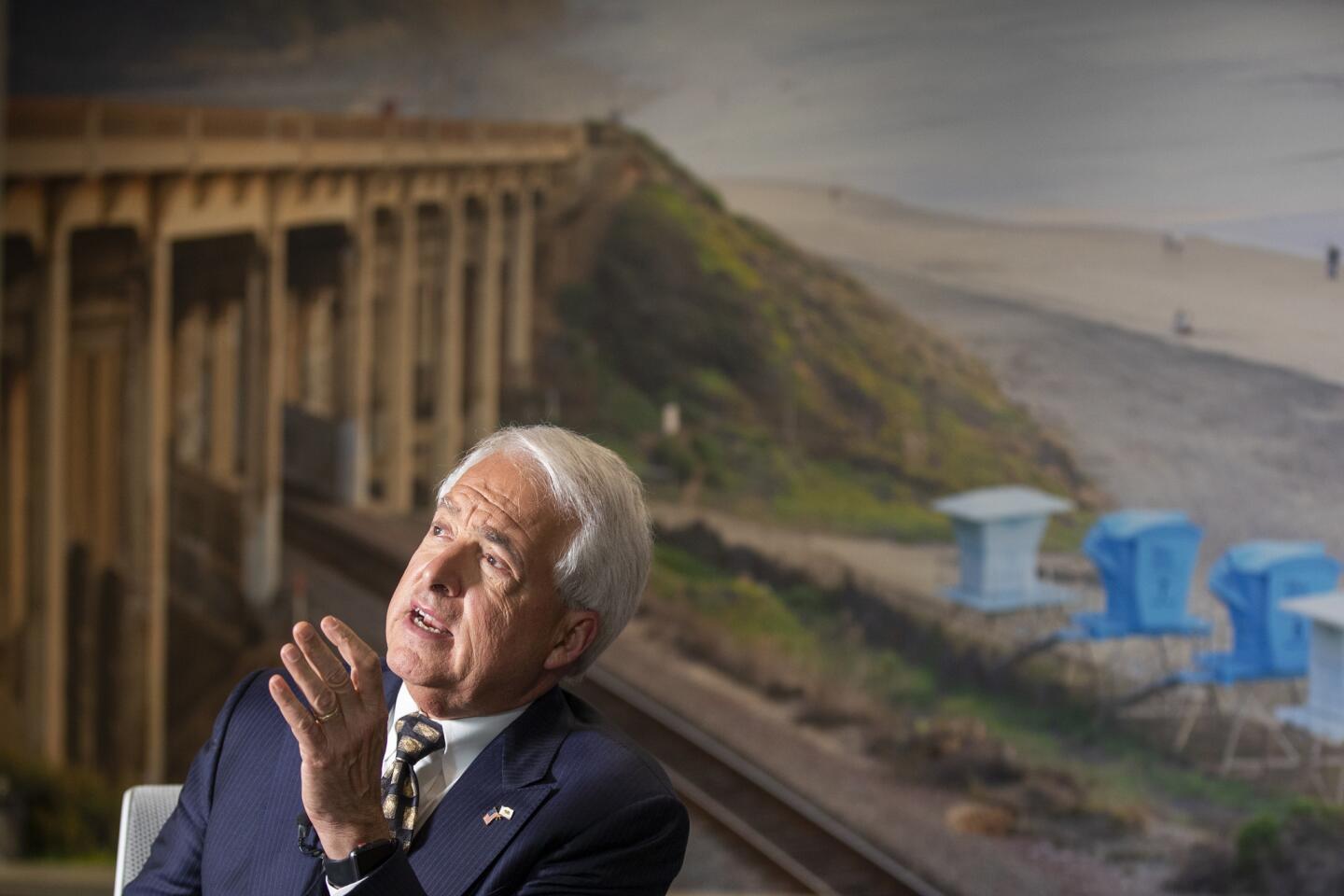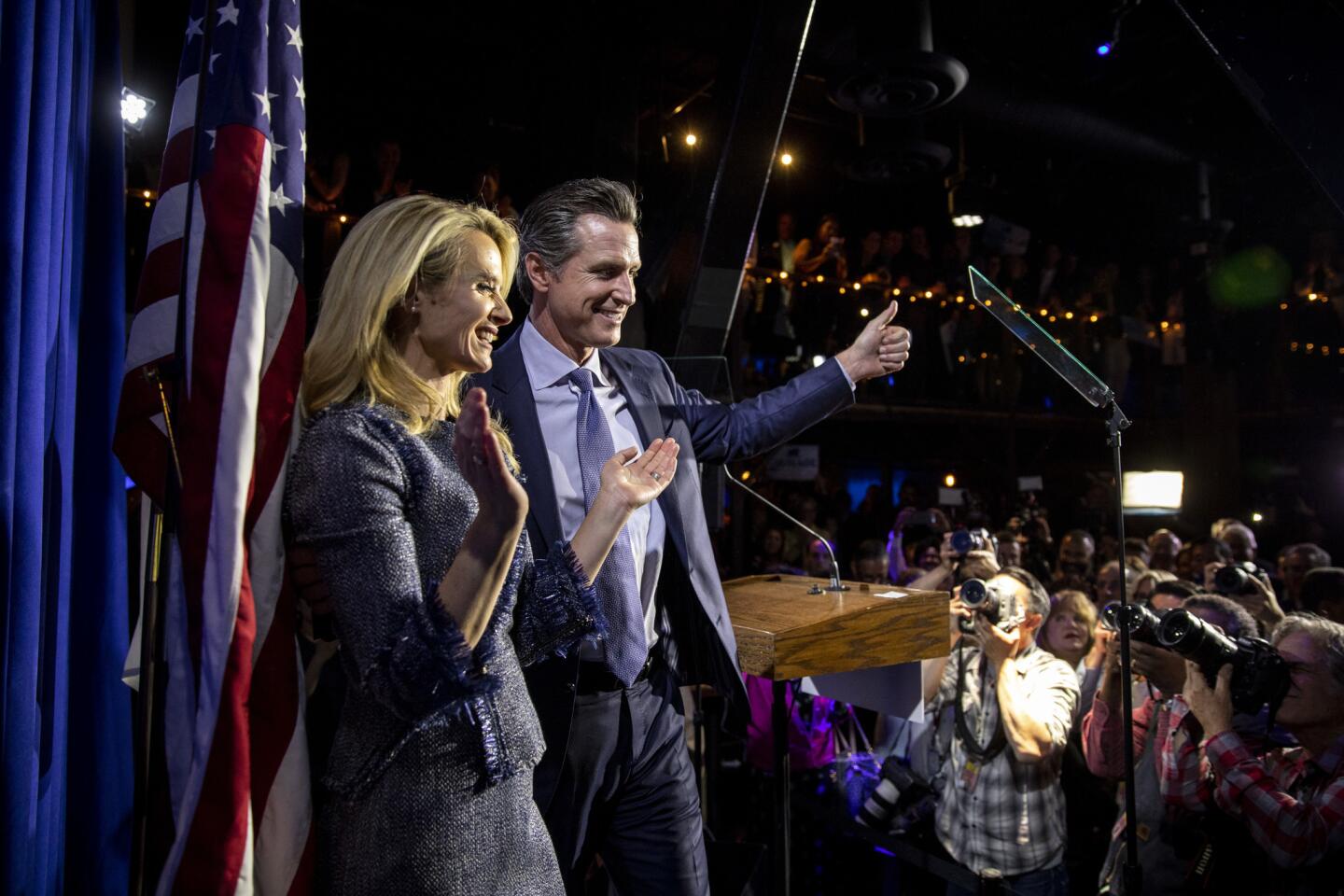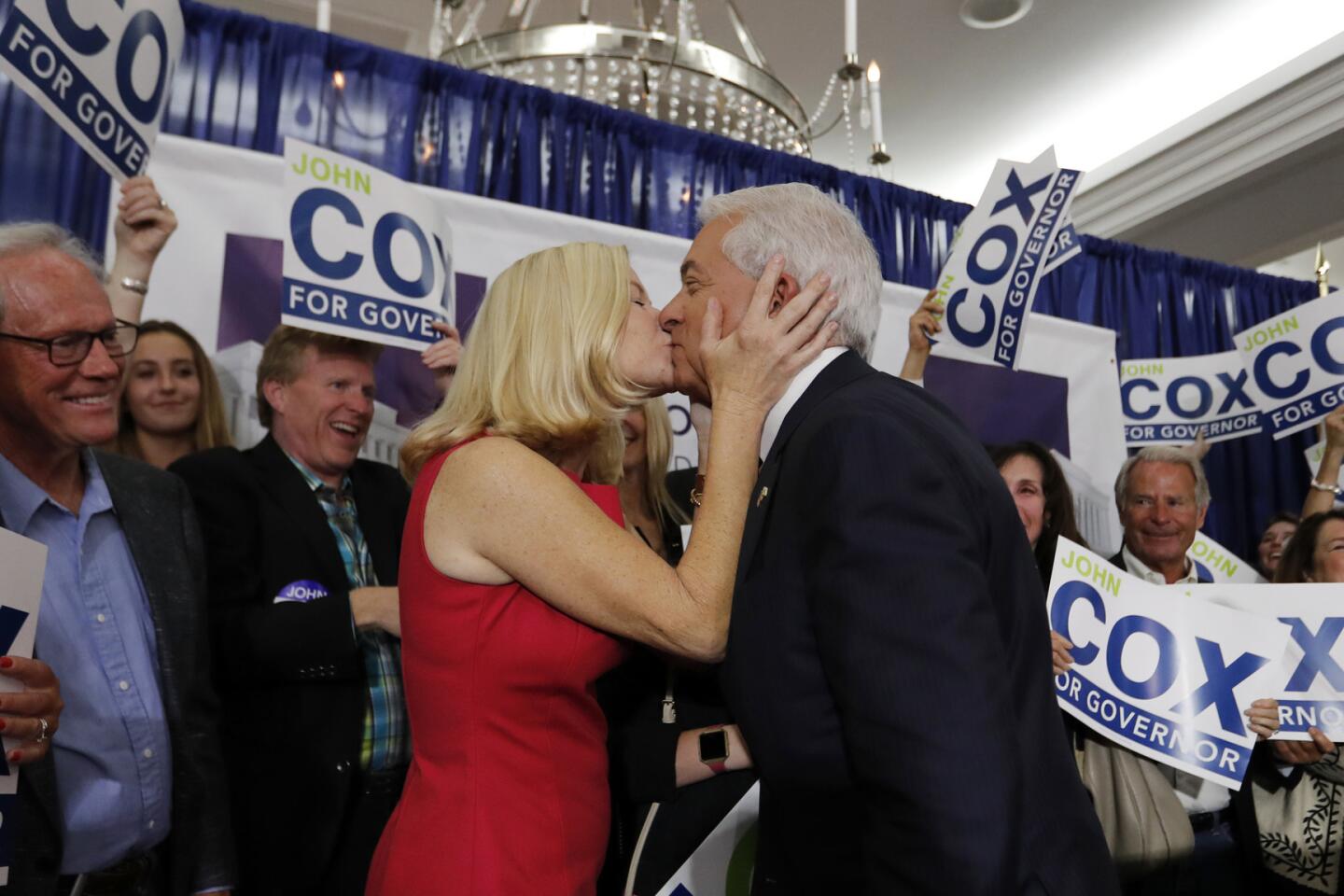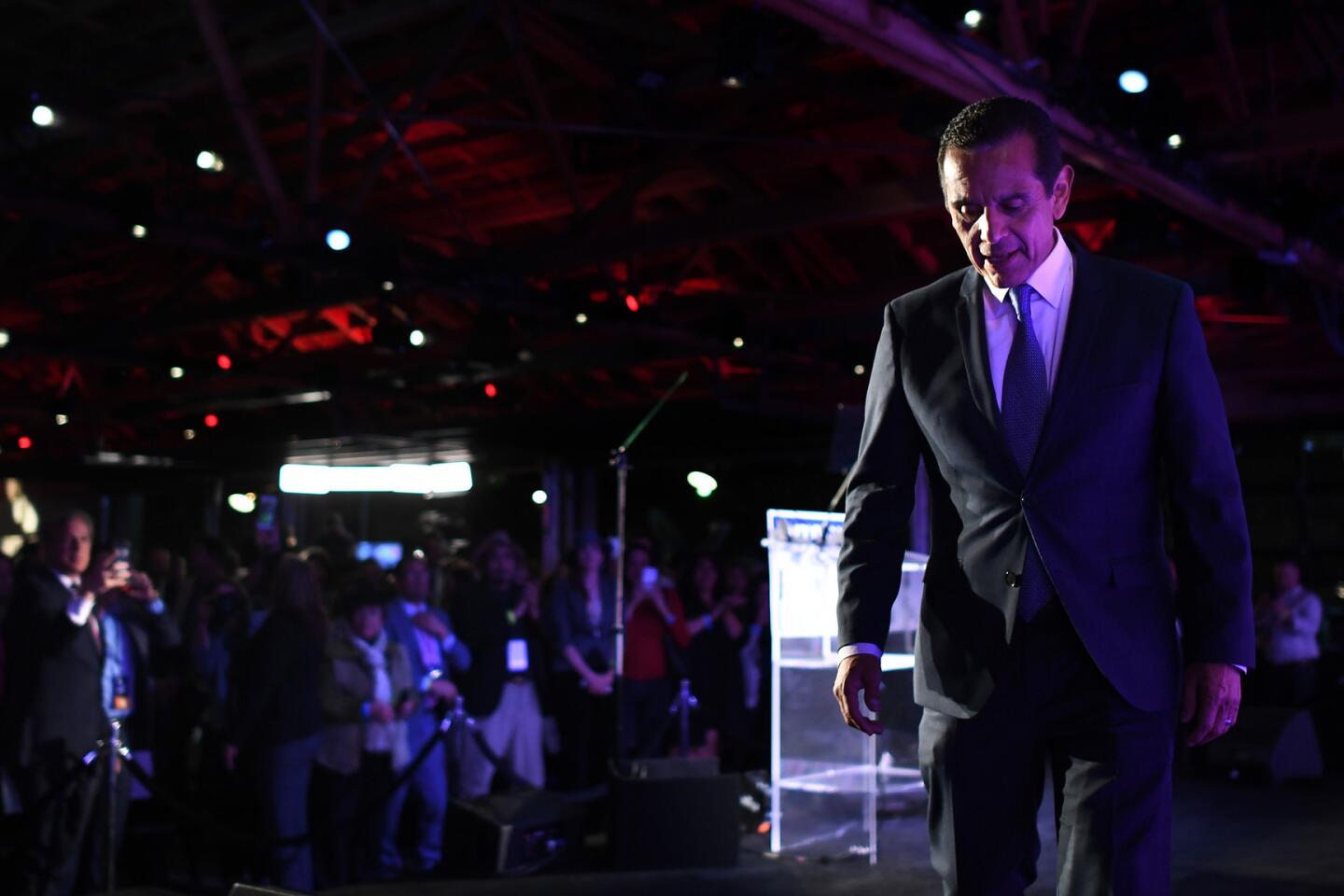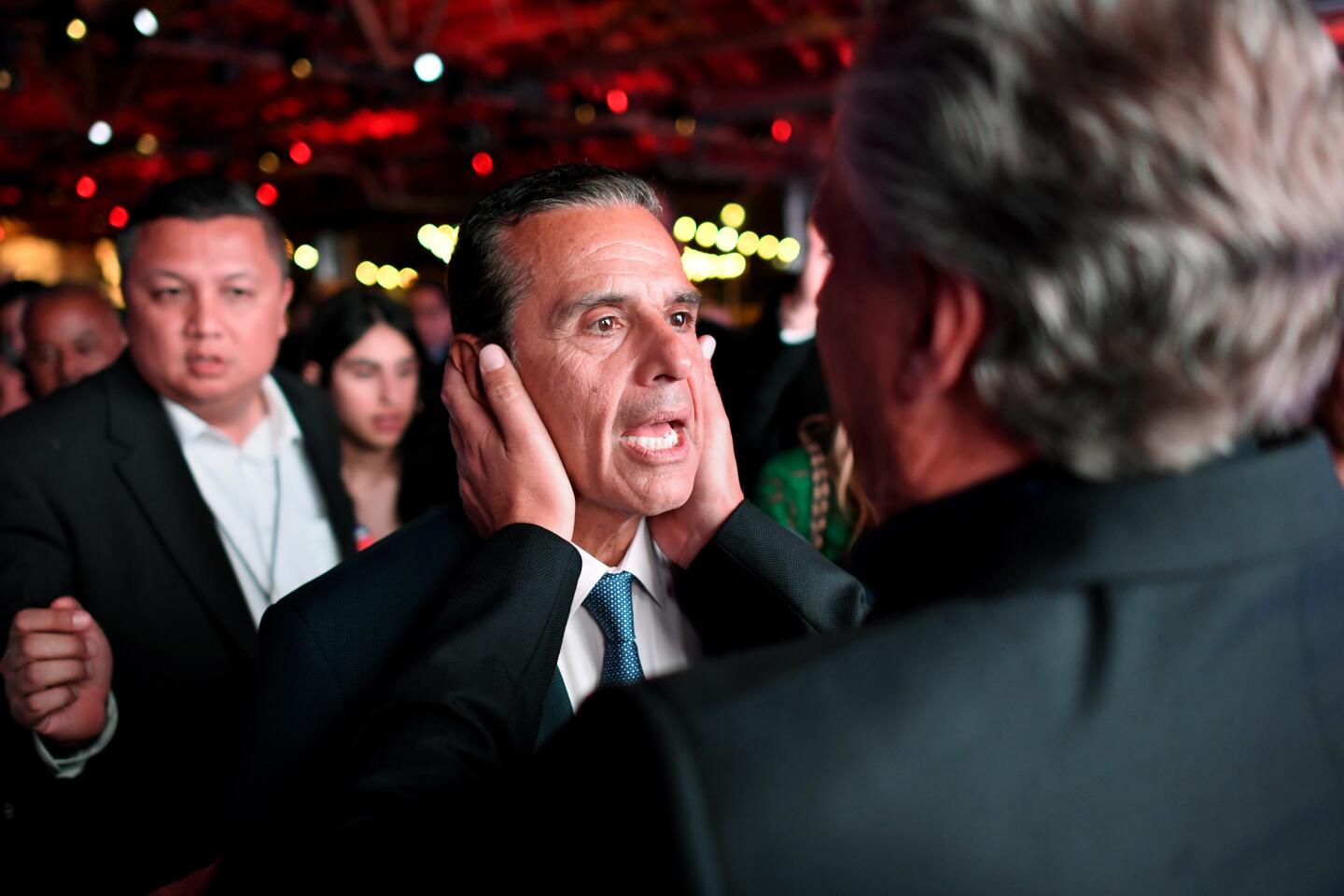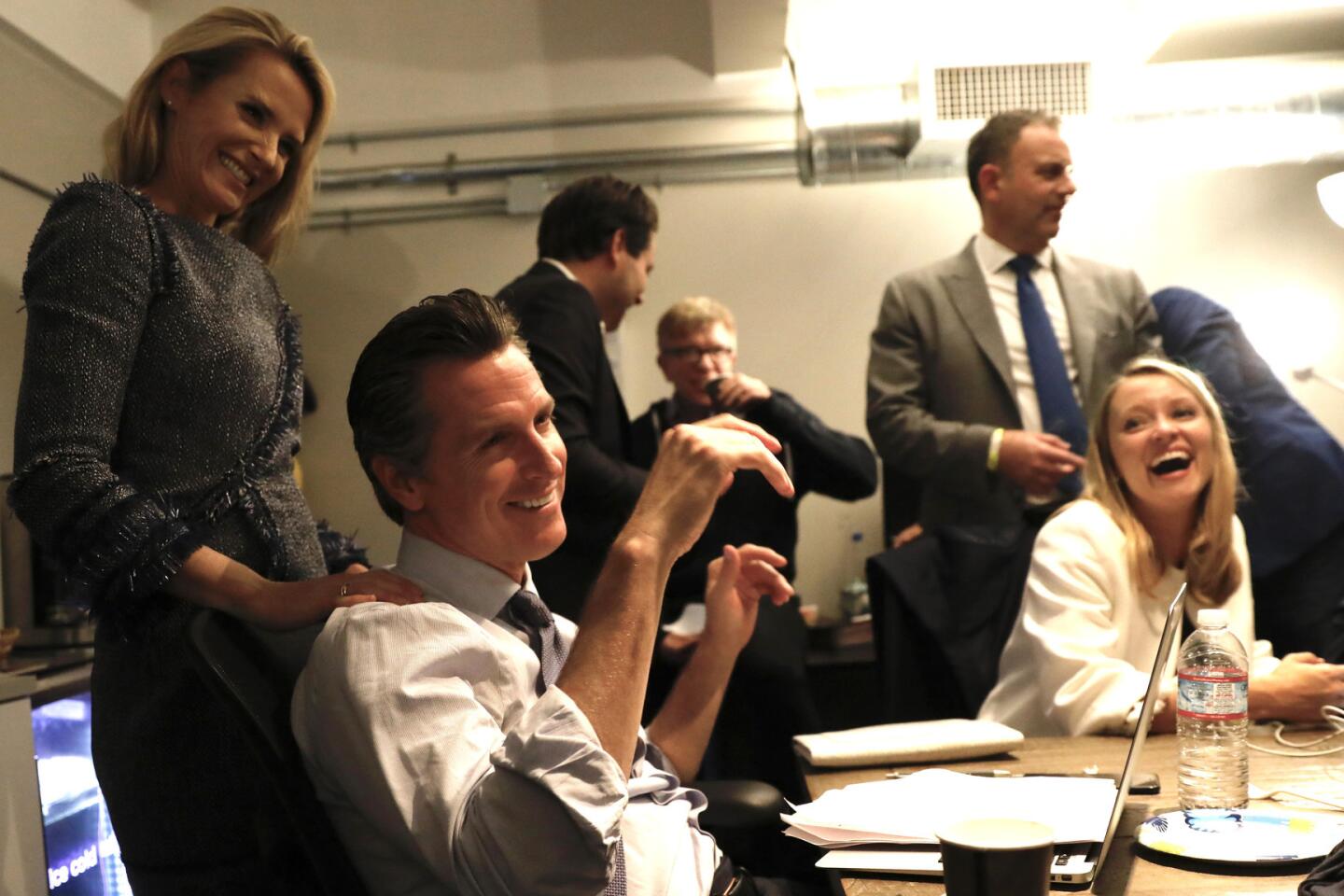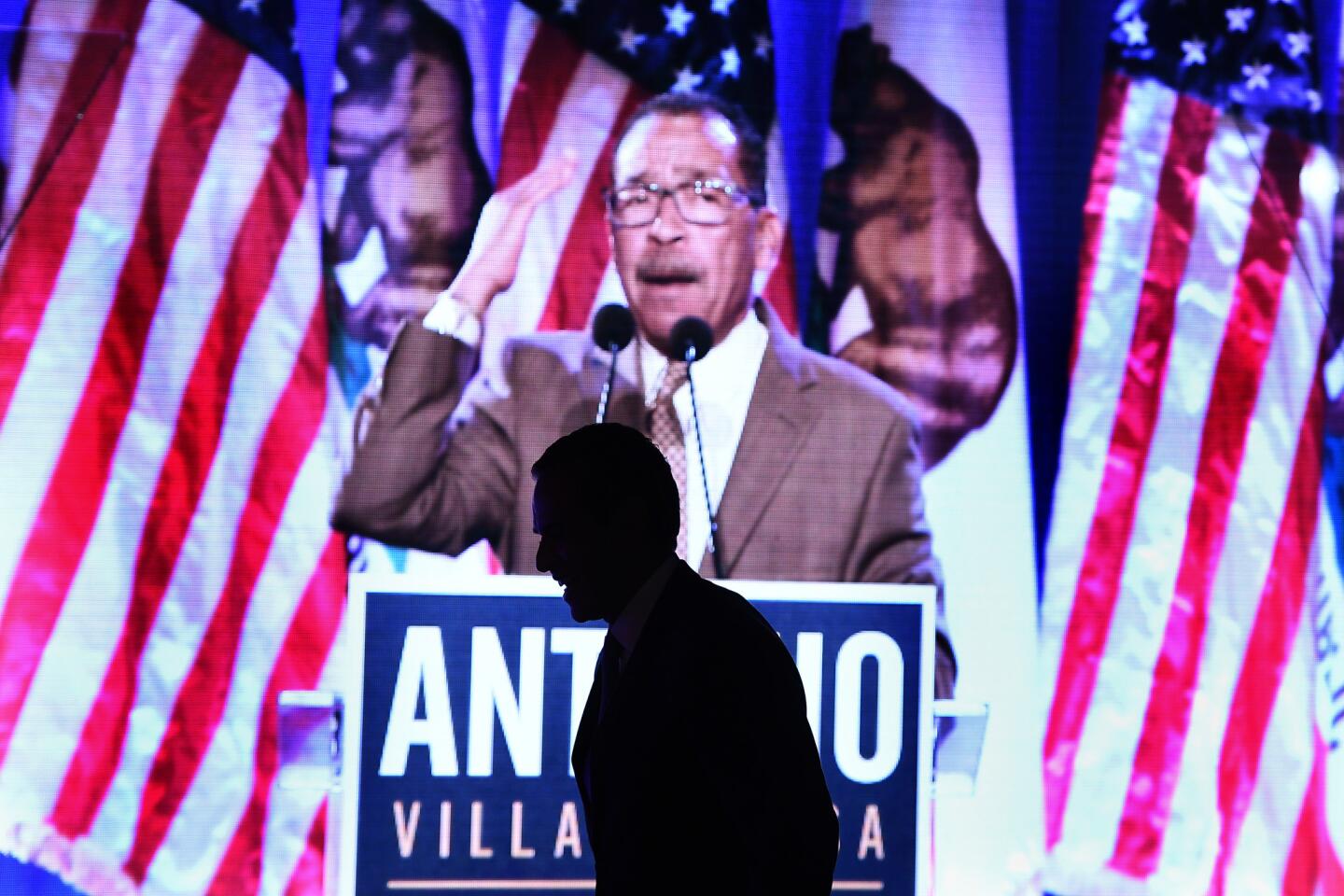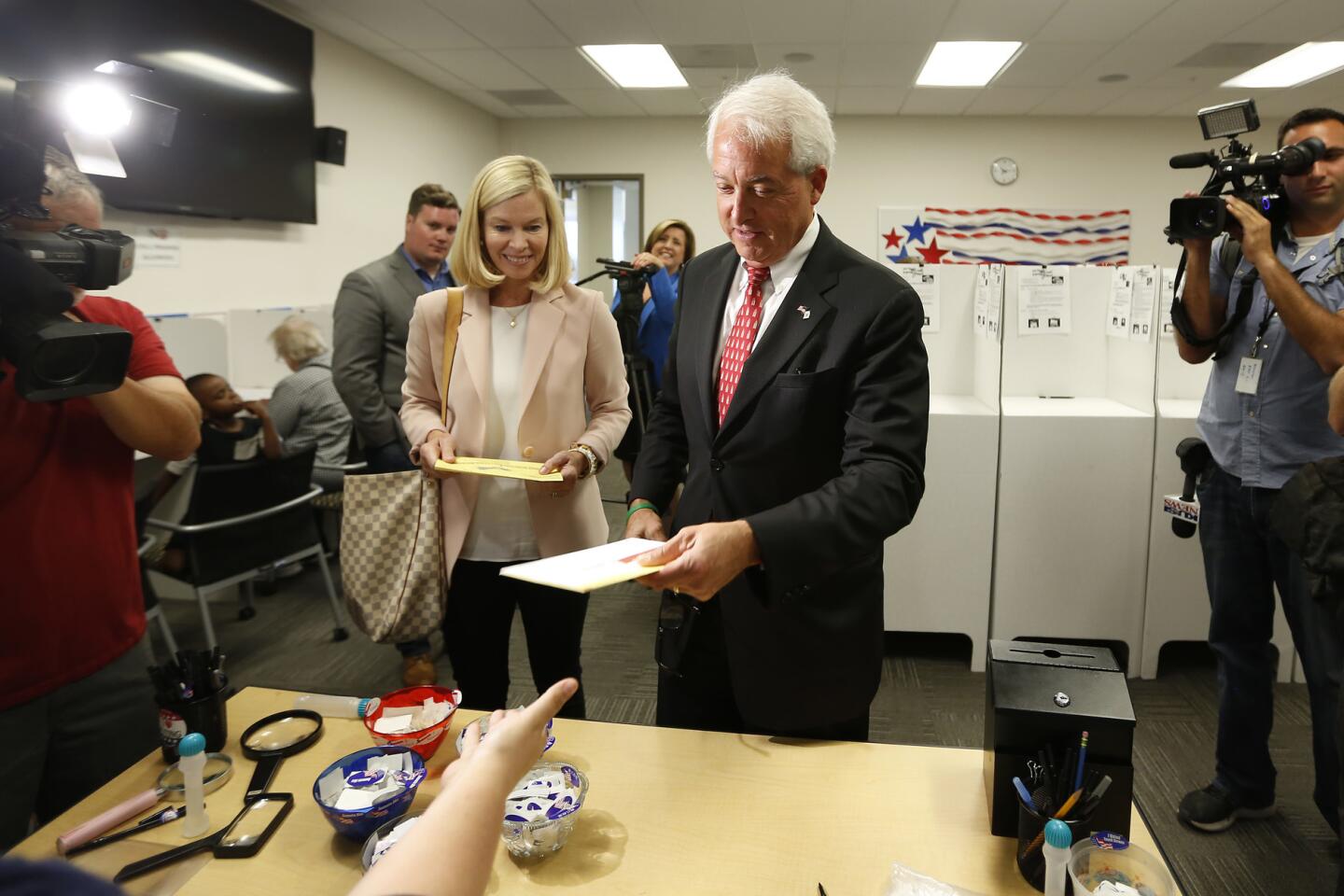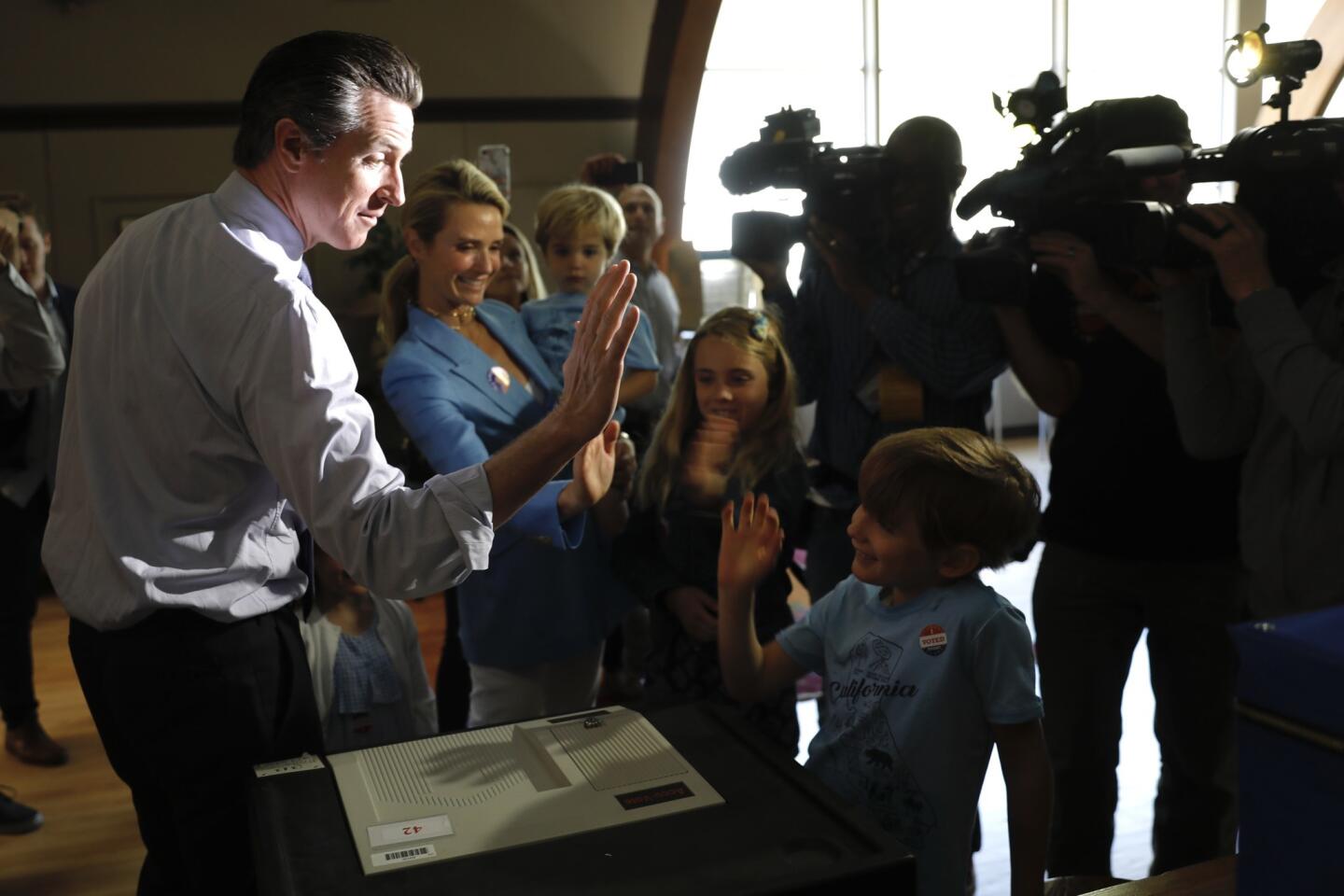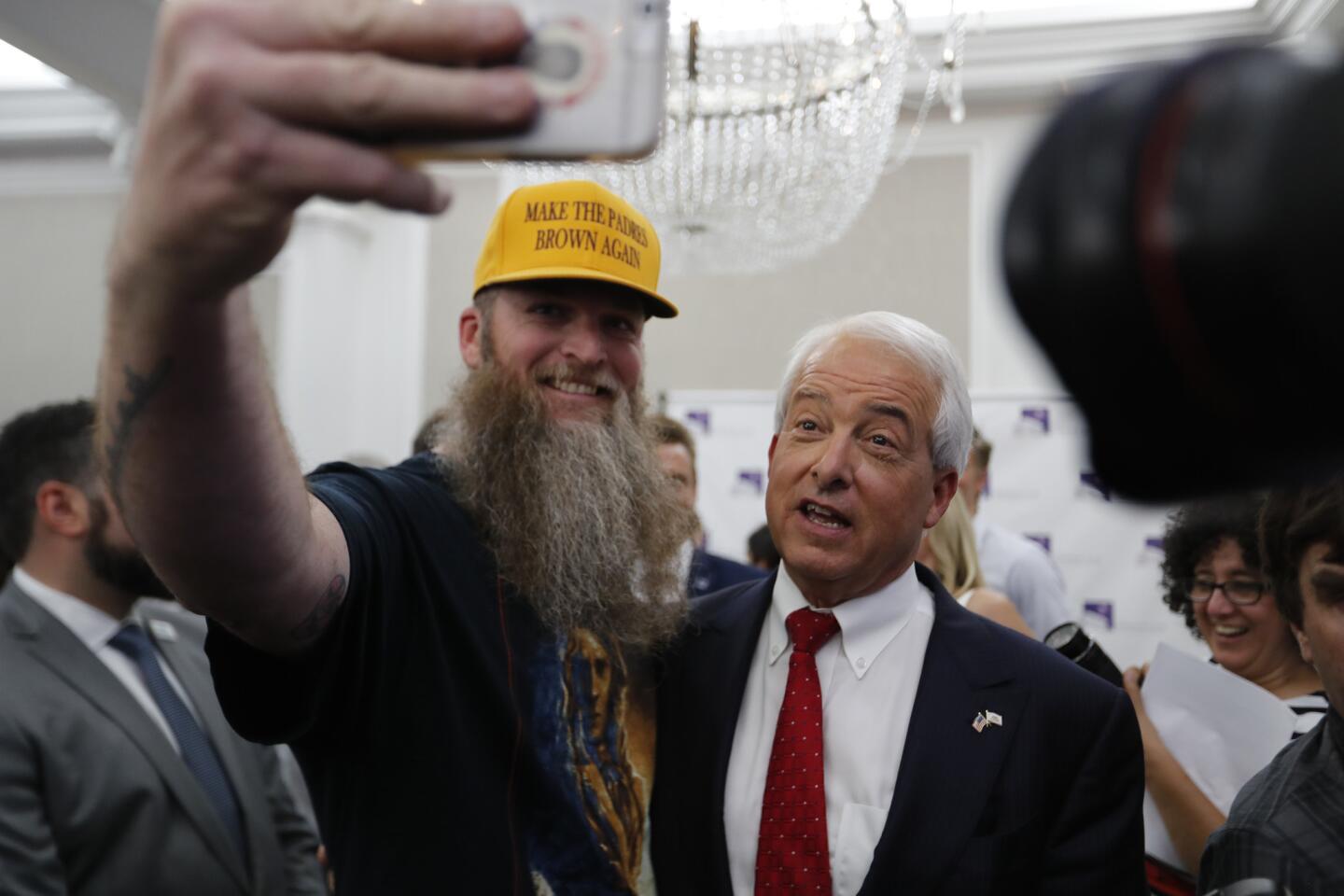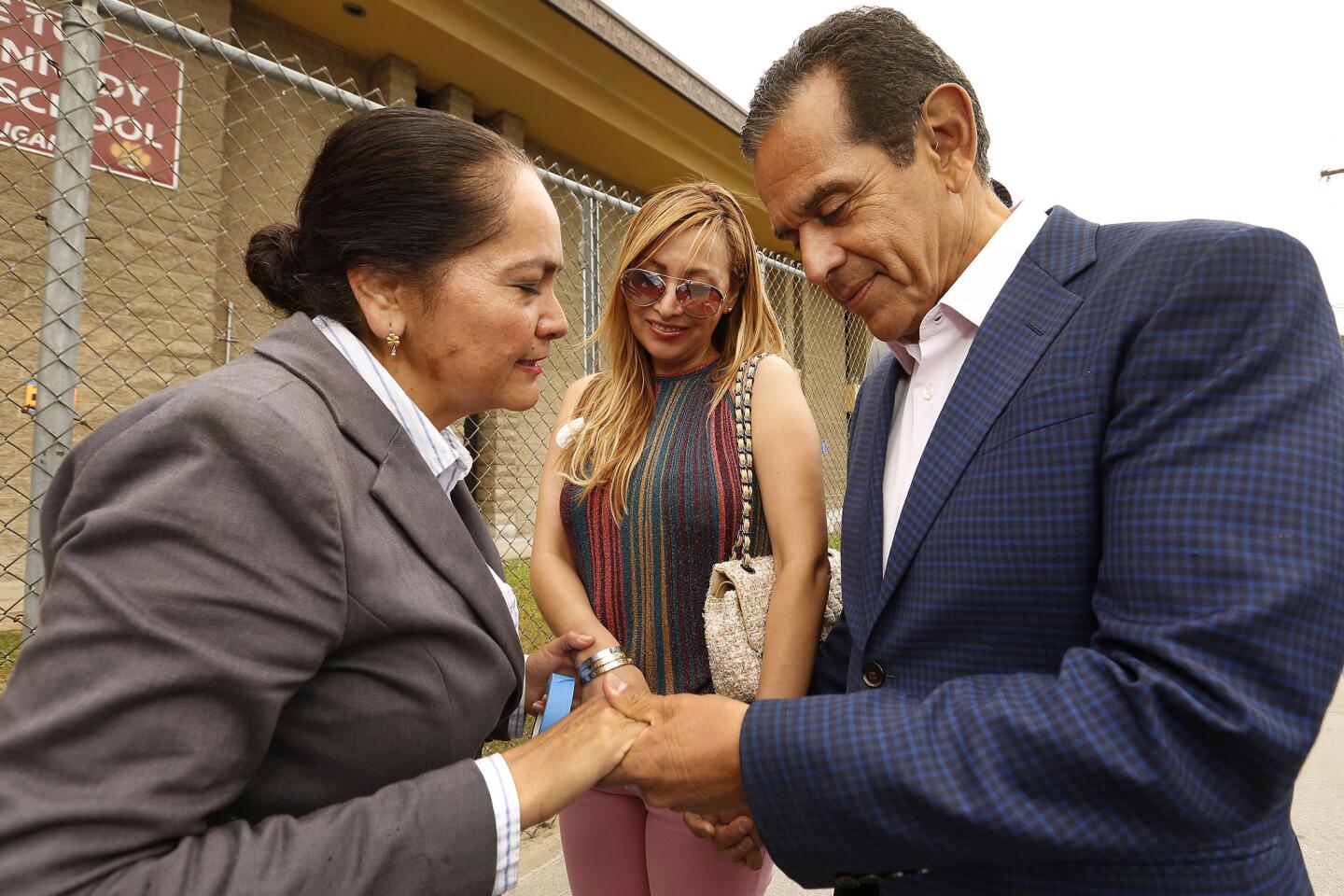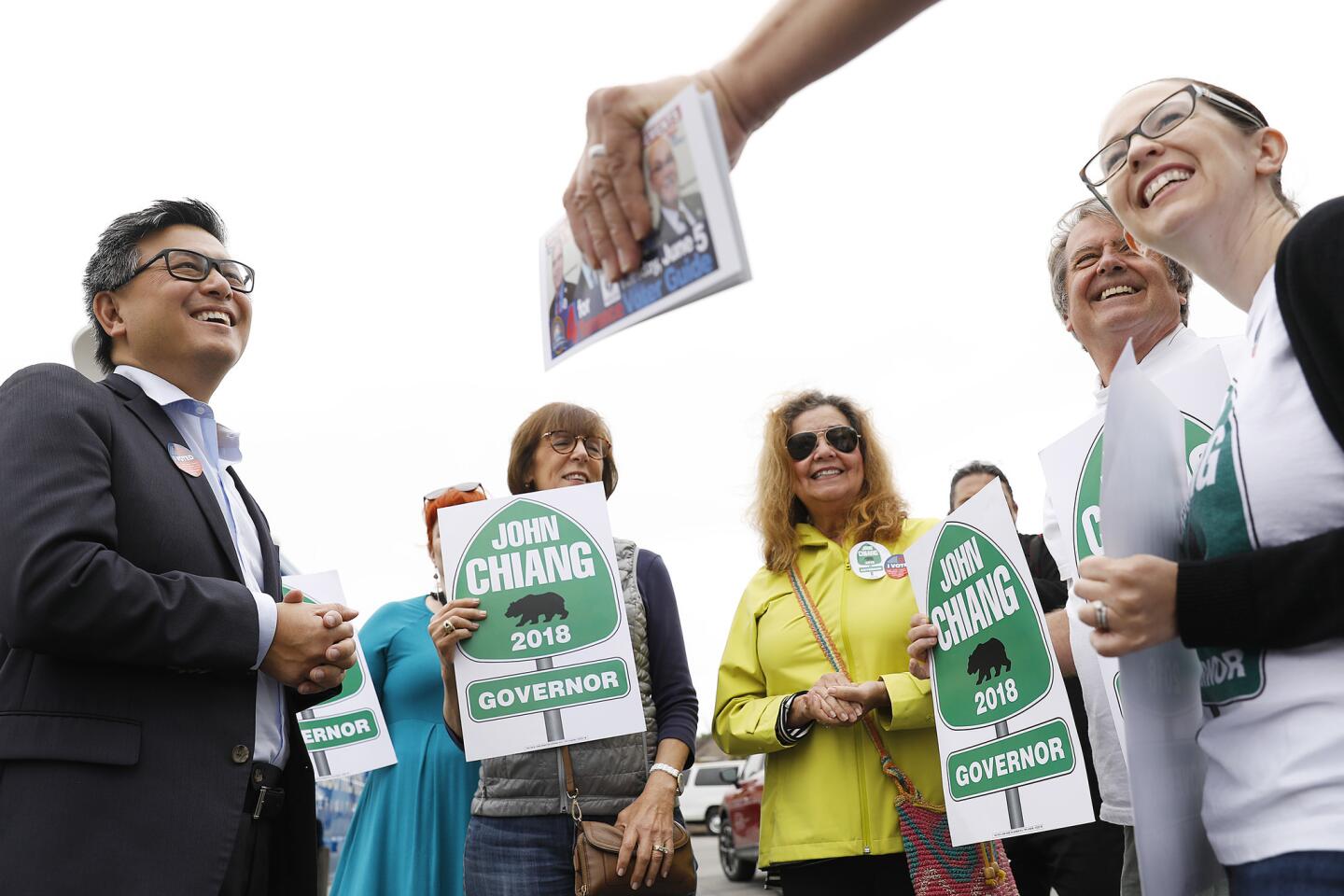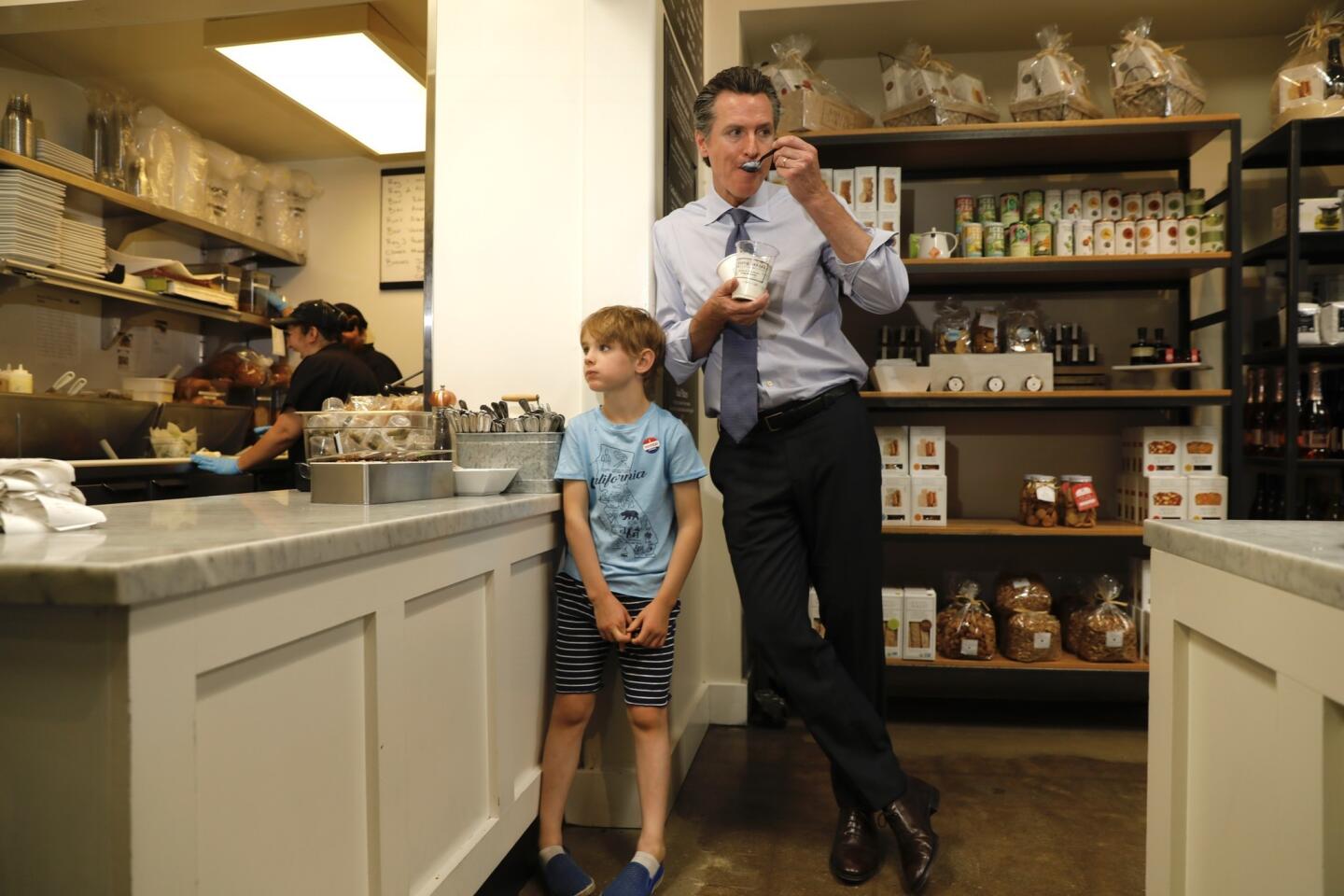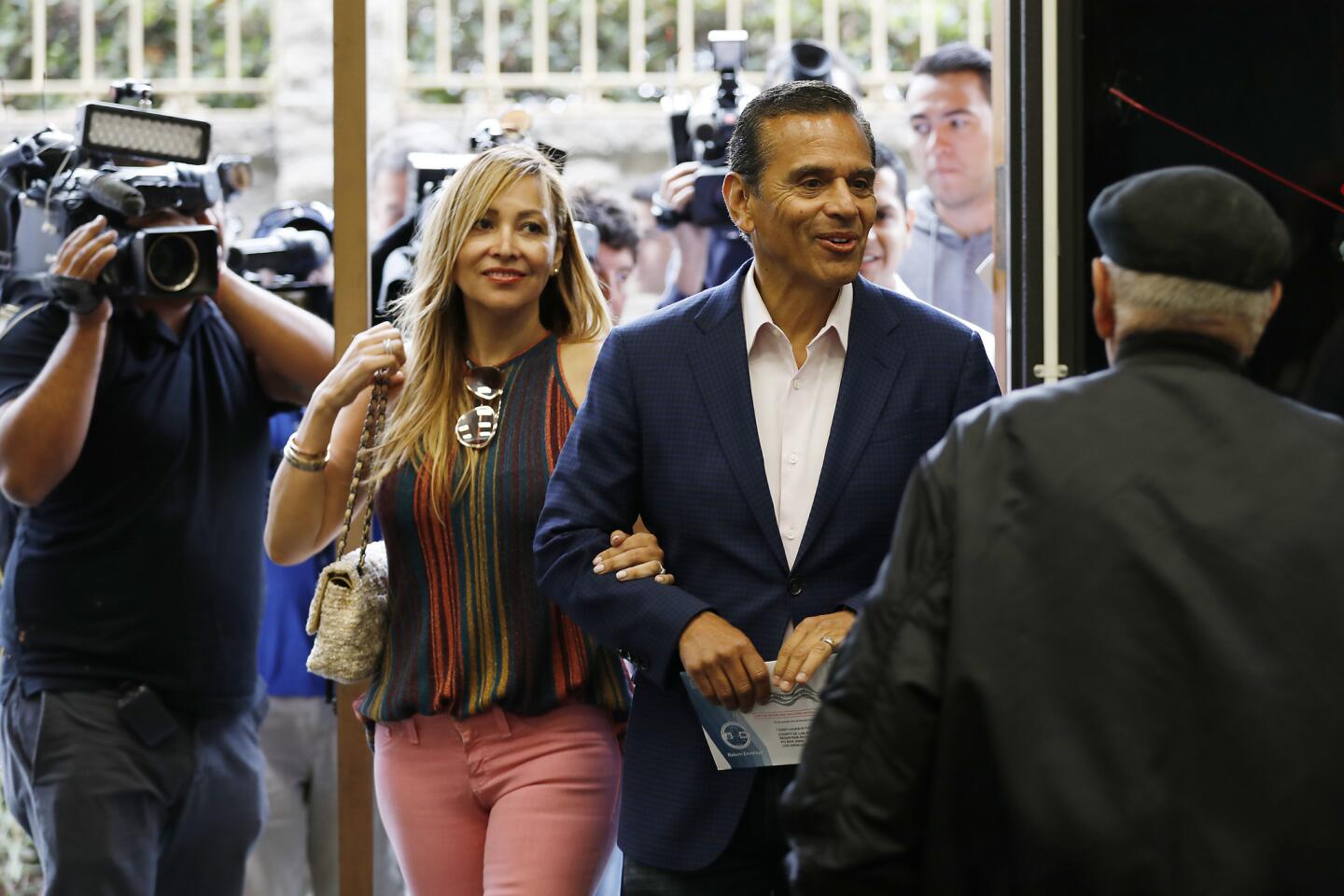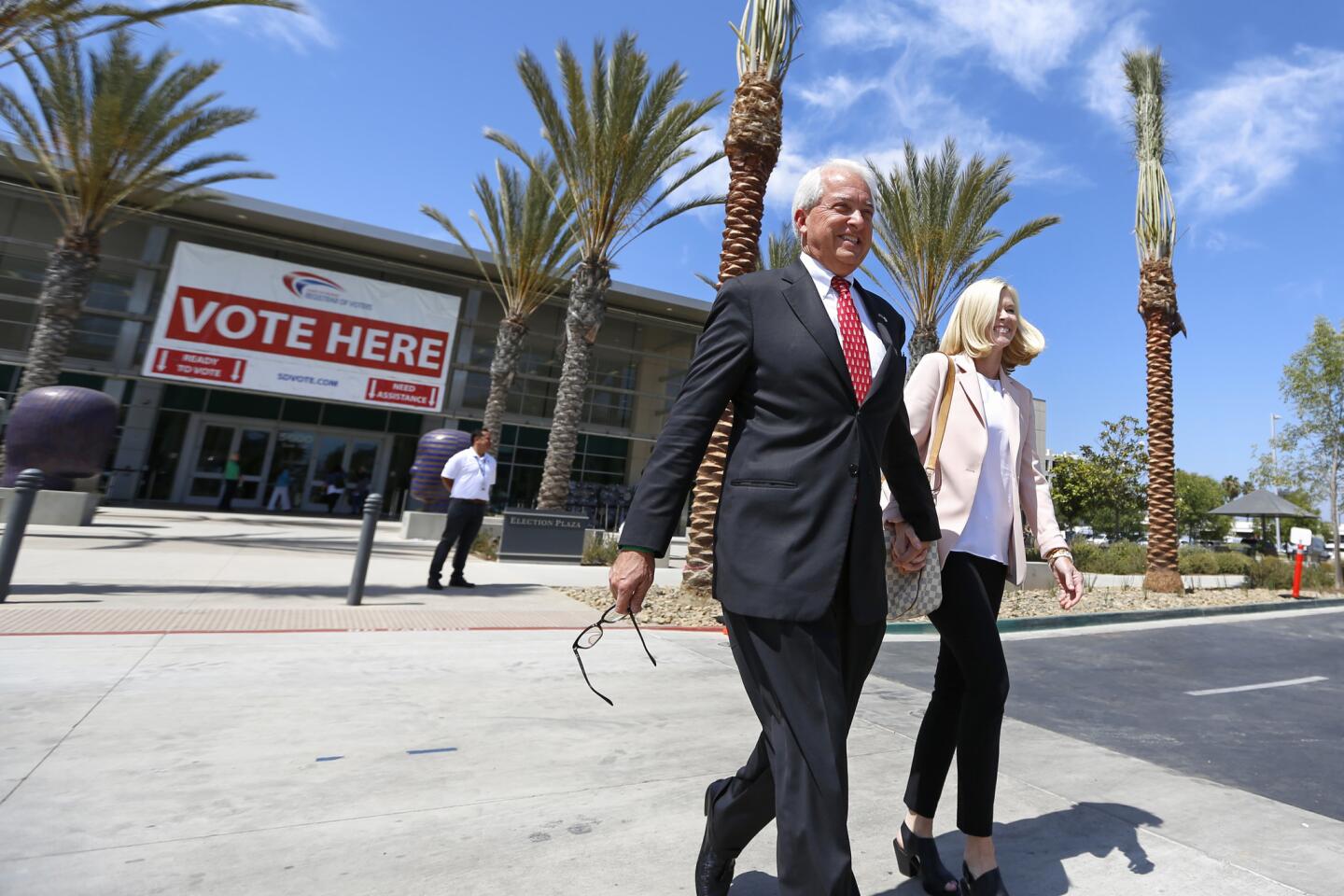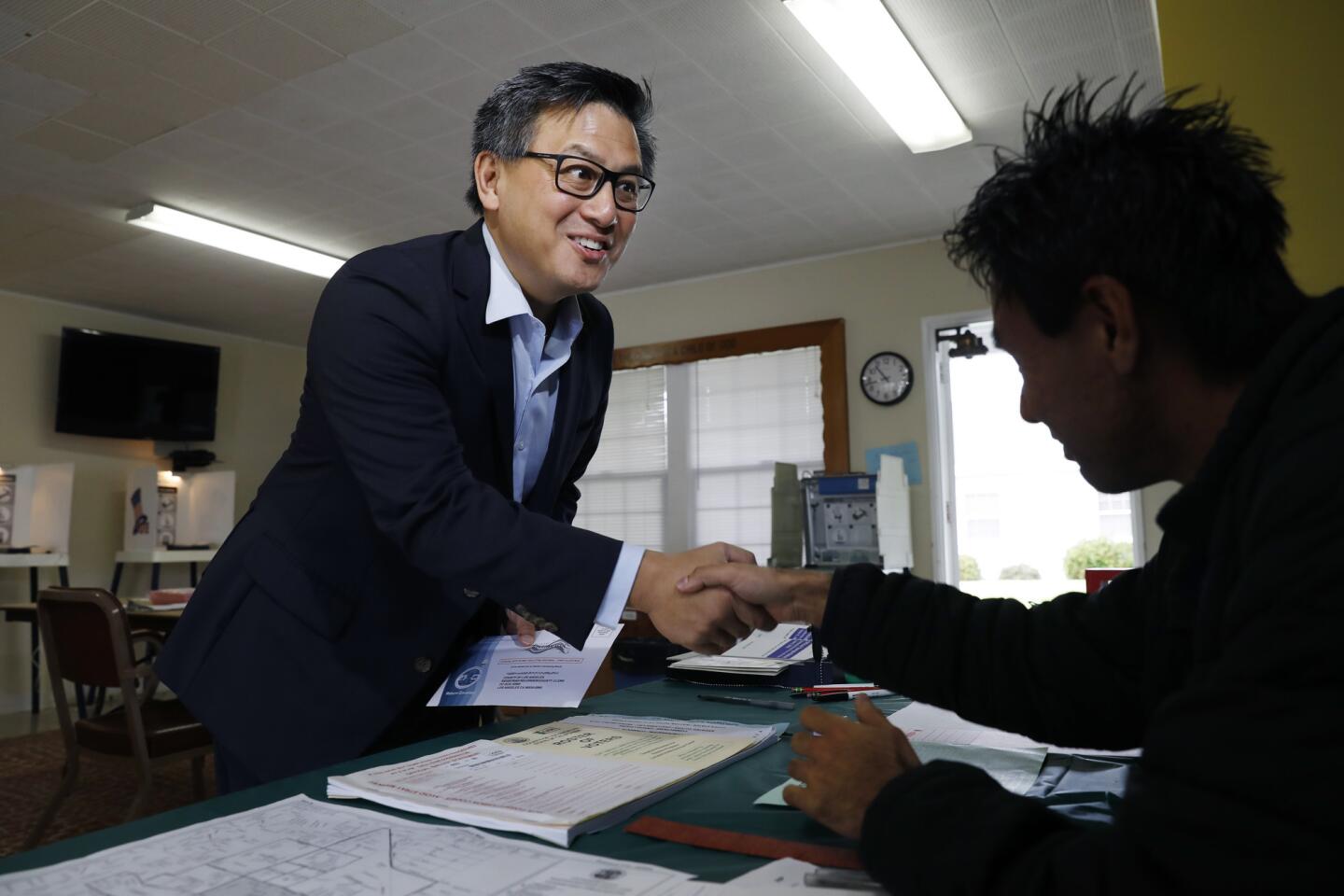It’s Newsom vs. Cox in November as Villaraigosa tumbles in governor’s race

Election night speech excerpts from Gavin Newsom and John Cox.
Gavin Newsom, the favorite of the California Democratic Party’s core liberal base, coasted to a first-place finish in Tuesday’s primary election for governor and faces a November showdown with John Cox, a multimillionaire Republican hitched to the far-right policies of President Trump.
The results mark a stunning defeat for former Los Angeles Mayor Antonio Villaraigosa, representing the fall of a politician who embodied the growing power of the Latino electorate when he was elected mayor in 2005. Villaraigosa conceded late in the evening, urging those who voted for him to give their support to his opponent.
For the record:
4:40 p.m. June 11, 2018In the June 6 Section A, an article about the California governor’s race said gubernatorial candidate John Cox ran for the U.S. House and Senate twice in Illinois, failing to reach the primary in all three. He failed to move past all three.
“I’m asking you to get behind Gavin Newsom,” said Villaraigosa, surrounded by his family. “I’m asking you to stand up and pressure every one of us — Democrat and Republican alike — pressure every one of us to stand up for you, to fight for you, not just for ourselves, but for all of us for an America and a California where every one of us are growing together.”
Newsom, 50, a former San Francisco mayor who is currently serving his second term as California’s lieutenant governor, will face Cox, 62, an Illinois transplant and real estate investor who ran for the U.S. House and Senate twice in Illinois, failing to reach the primary in all three. In 2008, Cox also launched a campaign for president before dropping out when he failed to gain any traction.
At Newsom’s election night party in San Francisco, the Democrat vowed to fight for universal healthcare and tackle the state’s housing affordability crisis, while promising to offer policy solutions instead of angry rhetoric.
“In politics today, there’s too much anger,” Newsom told his supporters. “Instead, we offered answers. Resistance with results.”
Cox has poured nearly $5 million into his bid for governor, but his political fortunes grew considerably when Trump fired off a tweet endorsing him in the final weeks of the campaign.
After a five-year hiatus from political office, Villaraigosa hoped to recapture the magic that led to his two terms as mayor of Los Angeles, but failed to stitch together support from enough Latinos, moderates and lower-income Californians to finish in the top two.
Where the candidates for California governor stand on the state’s biggest issues »
Cox declared a second-place victory Tuesday night and wasted no time blasting Newsom and the Democratic Party for California leading the nation in poverty, and government regulations that he said have made homes unaffordable, leading to an explosion of homelessness. In a preview of his general election campaign, Cox pinned the unpopular new gas-tax increase and the so-called sanctuary state policy squarely on Newsom.
“Mr. Newsom, you’ve had eight years, and your party has made a colossal mess of this once golden state,” Cox told supporters at an election night party held at the U.S. Grant Hotel in downtown San Diego.
Cox said California is in desperate need of a leader with business sense.
“Businesspeople have been elected to office as governor all across this nation to clean up the messes that the politicians have made,” Cox said.
Newsom also had a few words for Cox on Tuesday night, yoking the Republican to a president who remains extremely unpopular in California.
“California’s vision and America’s values are one and the same,” Newsom said. “But our values, as you know, are under assault. We’re engaged in an epic battle, and it looks like voters will have a real choice between a governor who will stand up to Donald Trump and a foot solider in his war on California.”
The election was the biggest test of California’s primary system, which advances to the general election the two candidates who, regardless of party, receive the most votes. Approved by voters in 2010, the top-two primary was envisioned as a way to elect candidates who better reflected California’s electorate, rather than the far-left and far-right nominees emerging from hyper-partisan party primaries.
In the run-up to election day, Newsom’s campaign made a brazen effort to tilt the primary to its advantage by attacking Cox in ads and on the campaign trail as Trump’s handpicked favorite and a rabid gun-rights supporter. The tactic was seen as a transparent attempt to elevate Cox among California conservatives so he would have enough Republican support to finish in the top two, squeezing out a more formidable Democrat. In left-leaning California, no Republican has won a statewide race since 2006.
Tuesday’s election also had controversy. After reports that more than 118,000 voters were accidentally left off the rolls at Los Angeles County polling places, Villaraigosa on Tuesday night called on elections officials to extend voting until Friday.
Newsom also benefited from several advantages in the campaign. He first entered the race in February 2015, more than a year before any of the other major candidates, and has topped the field in fundraising with tens of millions of dollars. And he hails from the Bay Area, which tends to back homegrown politicians and routinely sees higher voter turnout compared to Southern California.
The candidates running for governor and their allies spent more than $75 million on efforts to persuade voters before Tuesday’s primary. Though it was not the most expensive in California history, it broke records of gubernatorial primary spending by independent expenditure groups. As of Sunday, these groups had spent more than $34.4 million. The bulk of that money came from the nearly $22.7 million wealthy charter school backers spent in an effort to boost Villaraigosa.
Though Newsom decried the financial onslaught by Villaraigosa’s wealthy supporters, he was the beneficiary of millions of dollars in labor spending.
Newsom has presented himself to voters as a bold visionary, unafraid to tackle the most confounding issues facing California. He has promised to pursue a state-supported single-payer healthcare system if he’s elected in November.
Track the money that fueled the California primary for governor >>
“My whole life – we’ve faced down skeptics. Defeatist Democrats who suggest we need to ‘pick our battles,’” Newsom said at the California Democratic Party convention in February. “To me, this is more than a political campaign. It’s about Democrats acting like Democrats — in a battle for America’s soul against a president without one.”
Newsom has long eyed the governor’s office and has effectively been running since he launched a short-lived gubernatorial bid in 2009, later acquiescing to Brown and running for lieutenant governor instead. The early start allowed Newsom to sew up endorsements and lock down prominent donors, leading to his domination in the polls and fundraising since entering the race.
Cox jumped into California’s race for governor as a virtual unknown, a wealthy venture capitalist with a scant resume in public service and an unquenched thirst for the spotlight of political campaigns. He rose to the top of a GOP field distinguished by the lack of a prominent California Republican.
By tapping into his personal wealth, Cox was able to rise above his closest Republican challenger, conservative Assemblyman Travis Allen of Huntington Beach.
A lawyer and accountant, Cox championed the Republican-led effort to repeal the recently approved gas-tax increase and joined with conservatives in criticizing the so-called sanctuary state policy embraced by Brown and Democratic legislators.
From the outset, Cox has painted himself as a political outsider with the well-earned business sense to oust the “cronies” in Sacramento.
But it was the president’s endorsement that really energized the Cox campaign. Trump’s nod was largely seen as a pragmatic attempt to ensure a Republican was on the top of the ticket in November, which could increase GOP turnout and aid Republicans in a quest to hang on to their congressional districts in California.
The endorsement also shielded Cox after he came under fire from the right for admitting he voted for Libertarian Gary Johnson in the 2016 presidential election. Cox now says he backs the president “100%.”
Villaraigosa crafted a campaign focused on rebuilding the middle class and assisting Californians who have been left behind in California’s economy.
Before jumping into the race in November 2016, Villaraigosa spent months on a listening tour that crisscrossed the Inland Empire and Central Valley. Home to large Latino populations, the two areas, along with Los Angeles County, make up the political territory Villaraigosa needed to win to perform well in the election.
He flirted with a run for governor in 2010, shortly after the beginning of his second term as mayor. Villaraigosa ultimately decided he couldn’t “leave this city in the middle of a crisis” as Los Angeles struggled to recover from the economic ravages of the Great Recession.
Villaraigosa had strong support from law enforcement, thanks to a dramatic drop in violent crime in Los Angeles while he was mayor, and an unyielding commitment to growing the Los Angeles Police Department. But he ran afoul of teachers’ and public employee unions after his failed attempt to take over city schools and laying off hundreds of city workers during the height of the recession.
Two other prominent Democrats in the running for governor failed to gain traction with California voters.
State Treasurer John Chiang entered the race with promise, demonstrating an ability to raise millions of dollars and positioning himself as the workhorse competing against two show horses, Newsom and Villaraigosa.
Delaine Eastin, California’s former superintendent of public instruction, ran a campaign focused on education. The only woman among the top candidates in the race, Eastin received attention for her progressive platform and previous record as a statewide elected official.
Live coverage of California’s primary »
Everything you need to know about the June 5 primary »
Times staff writer Ryan Menezes contributed to this report.
[email protected]; [email protected]
Twitter: @philwillon @LATSeema
Twitter: @melmason
Twitter: @jaclyncosgrove
Updates on California politics
UPDATES:
11:30 p.m.: This article was updated to include Villaraigosa’s concession speech.
11:05 p.m.: This article was updated to reflect that Cox secured the second spot in the primary.
9:34 p.m: This article was updated to reflect that Newsom secured the top spot in the primary.
This article was originally published at 1:40 p.m.
More to Read
Get the L.A. Times Politics newsletter
Deeply reported insights into legislation, politics and policy from Sacramento, Washington and beyond. In your inbox three times per week.
You may occasionally receive promotional content from the Los Angeles Times.
